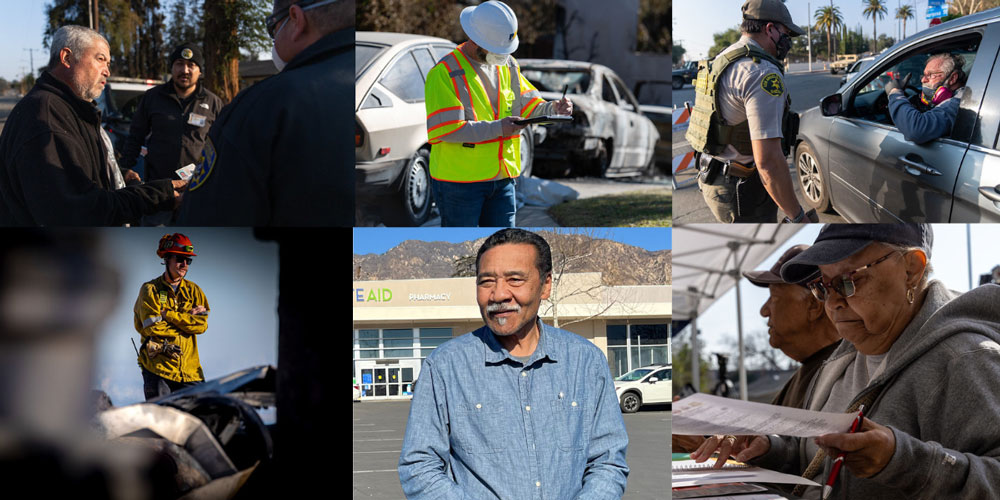
“Some mornings I reach for things that aren’t there anymore. We’re adjusting, but the emotional shift has been hard to process.”- Steve Gibson, LA Firestorm Survivor
Reflective. Hopeful. Grounded, and determined. These are the words that come to mind when listening to Steve Gibson recount the past 14+ weeks, post Los Angeles wildfires. Governor's Office of Land Use and Climate Innovation (LCI) and California Strategic Growth Council (SGC) staff first met up with Steve, an avid writer, educator, and advocate, on Jan. 23, 2025, while touring fire damaged areas in L.A. County. On January 8, he and his wife, Charlotte, fled their home in Altadena in the early morning hours - as the Eaton Fire swept through their neighborhood, leaving behind a trail of destruction that claimed more than 9,000 structures and 17 lives.
In January Steve spoke to the LCI Director and other state staff amid the rubble of homes that lined his once lush and bustling street. He detailed histories, relationships with neighbors, and the rich heritage his neighborhood was known for. Now, 100 days later, we caught up with Steve again to see how recovery was progressing for him and Charlotte, and their neighbors. Reflecting on the road to rebuilding, not just his Altadena home, but his Altadena community.
Steve and Charlotte have found temporary housing in Alhambra, but his resolve and vision remain firm – they will rebuild in Altadena. Our conversation was filled with honesty, reflection, and cautious optimism. Please take a few moments to read our Q&A with Steve Gibson—a leader, neighbor, and powerful reminder of what community/human recovery truly looks like.
LCI: Steve, it’s been 100 days since the fire. What stands out to you most when you think back to that night?
Steve: It was chaos. I remember waking up at 3 a.m. to an emergency alert—there was no power, just thick smoke and glowing embers outside. We grabbed our go-bags and our dog, Cantinflas, and drove off thinking we’d return in a few hours. But that was the last time we ever saw our home of 24 years. It still feels surreal. Some mornings I reach for things that aren’t there anymore. We’re adjusting, but the emotional shift has been hard to process.
LCI: How has life changed for you and Charlotte in the days and weeks since?
Steve: We're temporarily staying in Alhambra, and our insurance is covering 13 months here. We’ve signed with a prefab housing company in Gardena—mostly for speed. Traditional builders were quoting us two years minimum. So now, every day, we check if our Altadena lot has been cleared. Once that happens, we can lay the foundation and move forward. There’s a strange excitement to it, even though none of this was our choice. It’s a new phase of life—full of hard decisions, compromises, and unexpected blessings.
LCI: What does rebuilding look like for your family and your community?
Steve: We’re not just trying to rebuild homes—we’re rebuilding lives, connections, and futures. There’s a strong community spirit here. Neighbors gather to share resources, talk about contractors, and just be there for each other. It reminds me why I loved Altadena so much—its diversity, its history, the way people truly care. I’ve always believed in service, and now, I feel a deep responsibility to support others going through the same thing. We're all figuring it out together.
LCI: You talked to us in January about how much you hoped your neighbors would rebuild and not move away. How’s that going?
Steve: The Eaton Fire wasn’t just a wildfire. It was a historic rupture that destroyed homes, businesses, and cultural landmarks—like the Altadena Town & Country Club and the Odyssey Charter School. This neighborhood has deep roots, especially for communities of color who were pushed here by redlining. Right now, rebuilding our neighborhood is really mixed. Some of us are trying to rebuild what we once had, but others already have “for sale” signs up. I feel like insurance companies are estimating our payouts low, and permitting is taking a long time.
LCI: What gives you hope right now?
Steve: My community. The support from Pasadena City College was incredible—free meals, childcare, and even a Disaster Recovery Center at their Foothill campus. PCC students and faculty volunteered in so many ways. That’s what gives me hope: people showing up, quietly and consistently. This recovery will take years but knowing we’re not alone is making all the difference.
LCI: What do you want people to understand about this moment, 100 days out?
Steve: That recovery isn’t a straight line. It’s slow, layered, and emotional. But it’s also filled with opportunity—to rethink how we build, how we support each other, and how we prepare for the future. If there’s one thing I’ve learned, it’s that when people come together, real transformation is possible.
Steve Gibson’s journey reminds us that recovery is both a personal and collective effort. As we honor the 100-day mark since the firestorms, we stand with Steve and the thousands of Californians navigating loss, resilience, and renewal. Rebuilding homes is just the start—what we rebuild, and how we do it, will define generations to come.
Read more about Steve’s story today.
About the California Strategic Growth Council
The California Strategic Growth Council (SGC) is a 10-member council made up of seven state agencies and three public members with the mission to build healthy, thriving, and resilient communities for all. Funded through California’s Cap and Trade system and the California General Fund, SGC’s grant programs, strategic initiatives, and interagency coordination focus on multi-benefit and community-centric solutions at the nexus of climate and equity. Since 2008, SGC has invested more than $3.5 billion in projects strengthening communities and addressing climate change across California.

